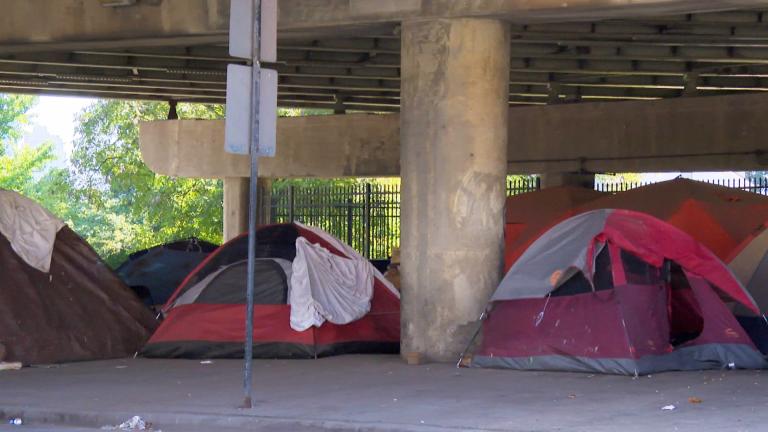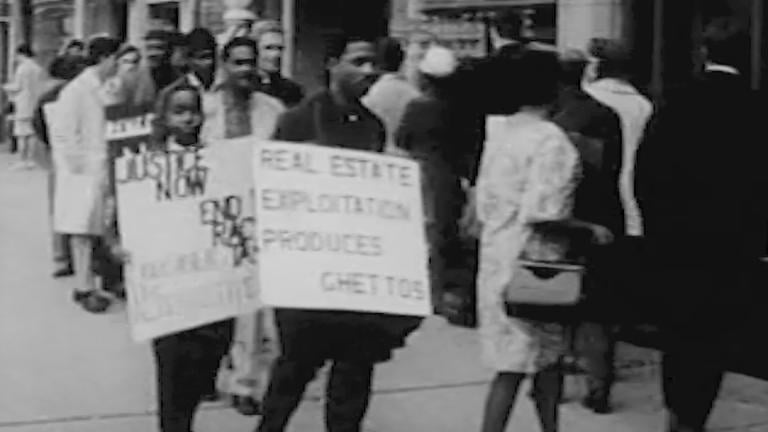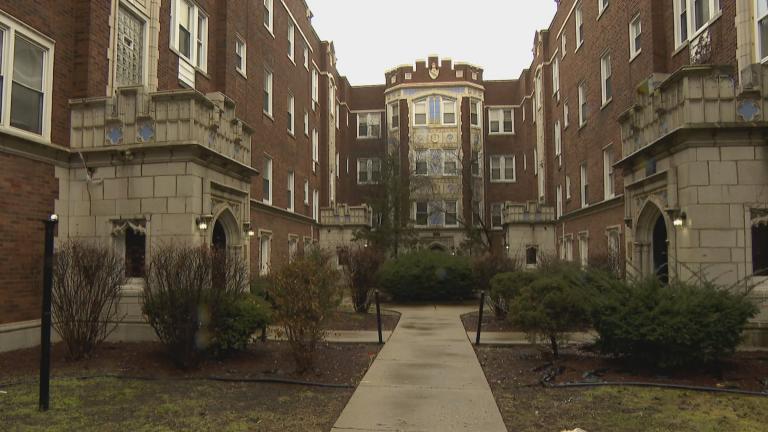There is a straight line between the scaffolding of modern segregation and the tens of thousands of vacant or abandoned properties on Chicago’s South and West sides, helping to keep Chicagoans mired in poverty for generations and fueling the drop in the city’s Black population, according to a new study from the Cook County Treasurer’s office.
Many of the barriers erected by elected officials and civic leaders beginning in the 1930s to keep Black Chicagoans, Latino Chicagoans and White Chicagoans from living, working and playing in the same neighborhoods remain unchanged nearly a century later, thwarting efforts to prevent abandoned properties from turning into eyesores that blight neighborhoods, according to “Maps of Inequality: From Redlining to Urban Decay and the Black Exodus,” a study Cook County Treasurer Maria Pappas’ office released Tuesday.
“It was like an ahha moment or an oh my God moment, where we said these two are correlated,” Pappas told WTTW News.
The treasurer’s most powerful tool to return those properties, known as “distressed” by government agencies, to productive use and generate tax revenue “has done little to halt the downward trajectory fueled by the government-sanctioned racism and other discriminatory practices,” according to the study, authored by Hal Dardick, director of research affairs for the treasurer’s office and a former Chicago Tribune reporter.
“Vast swaths of vacant lots, abandoned homes and boarded-up businesses in minority neighborhoods lie in areas where the U.S. government had discouraged mortgages,” according to the study. “Government-sanctioned redlining from the 1940s led to today’s urban decay in many Black and Latino communities.”
The Federal Housing Administration, created in 1934, explicitly refused to back loans not just to Black people who wanted to buy homes but also to those who lived near Black people on the basis and belief that those investments would not pay off. That practice came to be known as redlining.
Neighborhoods where homes could not be sold to Black people – and remained racially homogeneous – were designated with green lines first by the New Deal’s Home Owners’ Loan Corporation and then the Federal Housing Administration, creating a self-reinforcing system that served as the infrastructure of modern segregation.
The treasurer’s study mapped 41,450 properties considered distressed by the treasurer’s office, city of Chicago or the Cook County Land Bank in 2022 and found that nearly 63% of those properties were included on maps created in 1940 by the federal government in an effort to boost home ownership by encouraging banks to make mortgage loans — but only in places where White Chicagoans live.
Nearly 57% of those Cook County properties now considered distressed included on those maps were “redlined” in 1940 — warning banks those areas would be “hazardous” to invest in, with an additional 40.5% “yellowlined” — warning banks those areas were “declining.”
Less than 3% of distressed properties today were rated as “best” or “still desirable” by federal officials in 1940, according to the study.
“There it was,” Dardick told WTTW News. “It was really obvious.”
The system of modern segregation created a nearly immutable “pattern of urban decay” in Chicago — replicated in Detroit and Philadelphia — that has had a profound impact on the lives of Black and Latino Chicagoans, helping to fuel the massive racial wealth gap that continues today, according to the study.
“Neighborhoods today are suffering because of what the government did 80 years ago,” said Dardick, calling the problem of vacant and abandoned properties a “monumental problem that doesn’t just effect Black folks or Latino folks, it effects the whole city, the health of the whole city.”
Those maps also distorted Chicago’s real-estate market, making it possible for unscrupulous property owners to exploit Black residents eager to get their share of the American dream through contract-buying schemes, which they were falsely told would allow them to own home and build generational wealth, in areas covered by racially restrictive covenants.
The study draws a direct line between the concentration of vacant and abandoned properties on the South and West sides and the drop in Chicago’s Black population that began in the 1980s and has only accelerated.
“Systemic housing discrimination continues to rob communities of wealth, and we really need to turn that around,” Dardick said.
The 15 wards with the highest number of properties considered distressed by Chicago and Cook County officials all lost population between 2000 and 2020. All are home to a majority of Black or Latino residents, according to the study.
“One example of that continued decay can be found on a single redlined block in North Lawndale, where one in four properties became vacant lots between 1938 and 1973 — before doubling to one in two, where it remains today,” according to the study.
On that block, near 15th and Christiana streets, the city owns 13 lots, according to the study.
“The blight harms neighborhoods already facing entrenched poverty, rampant crime and dwindling populations,” according to the study. “Concentrations of vacant lots and abandoned properties exacerbate crime issues and lead to lower property values.”
Fourteen of the 15 wards with the most distressed properties had violent crime rates that were higher than the citywide average during the decade ending in 2020, accelerating already entrenched rates of disinvestment and population loss, the study concludes.
Driven by “discriminatory lending policies that boosted the costs of home ownership, [these distressed properties] were abandoned by Black people who could no longer afford them,” according to the study.
In the south suburbs, at least one in four taxable properties in Dixmoor, Ford Heights, Harvey, Phoenix and Robbins are considered distressed. That has shrunk those towns’ property tax bases so significantly that the governments are struggling to operate — while raising the tax burden on other property owners to “onerous” levels, creating a vicious circle of disinvestment, according to the study.
Scavenger Sale’s ‘Dismal Record’
The study concludes that the scavenger sale, Cook County officials’ most powerful tool to breathe new life into these distressed properties, is woefully inadequate, in part because it was launched in 1943 by the same officials who created the system of modern segregation in the first place.
“The scavenger sale is mostly a symptom of the problem,” Dardick said. “We knew that it wasn’t working, but we didn’t know the cause. You have to know how you got there to try to address the problem.”
While properties auctioned off in the scavenger sale accounted for just 1.5% of all Cook County properties, 95% of those properties were concentrated in areas where a majority of residents are Black or Latino, officials said.
The scavenger sale takes place every two years, allowing the treasurer’s office to put vacant and abandoned properties with at least three years of unpaid taxes up for auction. Bids start at $250, with an additional $190 fees.
Property owners have another opportunity to pay their back taxes and penalties and regain full ownership. But if they miss the deadline, the winning bidder gets the deed to the property, often after paying only a fraction of the property taxes owed.
However, few bids result in a final sale, and the bulk of the properties remain eyesores and magnets for crime, according to the study.
More than 93% of properties auctioned off in at least one sale had been included in at least one previous scavenger sale between 2007 and 2019 — “another sign the sale is an inadequate remedy,” according to the study.
Pappas first sounded the alarm that the scavenger sale was not working in a 2020 study, and made a series of changes to the program designed to make it more effective in revitalizing vacant or abandoned properties.
But nearly a year and a half later, Pappas acknowledged those changes — while boosting the number of bidders and increasing the program’s transparency and accountability — have failed to fundamentally alter the dynamic.
“The sale’s inability to make anything but incremental change allows swaths of unused, deteriorating land in economically struggling, mostly minority city neighborhoods to continue deteriorating,” according to the study.
Cook County is the only place in the nation to auction off properties that have fallen behind on property taxes, according to the study.
A state law allows Illinois counties to put liens on properties that have past–due bills and hold them in a trust, easing the process to selling them to new owners — and Cook County should adopt a similar system, the study concludes.
“Now that we have figured out the origins, we’re going to take a step further and try to move to the ball forward and address this problem holistically,” Dardick said, adding that it will take changes to both state and local laws to put a “more efficient, fair system of putting properties back to productive use that can benefit the people in those neighborhoods.”
Pappas also wants to cut the annual interest rate on delinquent property taxes from 18% to 9%, in an effort to get more properties back in compliance.
“What this report does is go beyond anger and upset,” Pappas said. “This report goes to solutions.”
Contact Heather Cherone: @HeatherCherone | (773) 569-1863 | [email protected]








